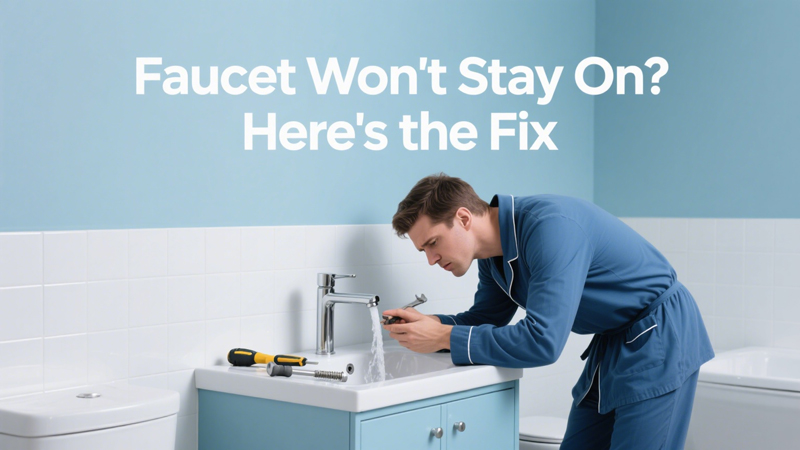Faucet Won’t Stay On? Here’s the Fix
View Count:88 CategoryBlog
A faucet that won’t stay on is not just annoying—it’s disruptive. Whether you’re trying to wash your hands, rinse vegetables, or fill a bucket, you expect your faucet to do one thing: deliver water when you turn it on. But when the water flow cuts out unexpectedly or the handle won’t hold its position, it’s a sign that something is wrong.
This issue can happen in both kitchens and bathrooms, and it might result from anything from simple wear and tear to more complex internal failures. Fortunately, many of these problems are easy to diagnose and fix—even if you’re not a plumbing pro.
In this post, we’ll break down why your faucet won’t stay on, how to identify the root cause, and what you can do to fix it quickly and effectively.
Common Symptoms
Before diving into the fix, make sure you understand what the problem actually is. A faucet that “won’t stay on” might exhibit one or more of the following:
Water flows briefly, then shuts off
Handle won’t lock in the “on” position
Faucet handle springs back or feels loose
Water pressure drops sharply after turning it on
Inconsistent or intermittent water flow
These symptoms can apply to standard faucets, touch-activated models, and motion-sensor taps, so diagnosing the issue requires understanding the type of faucet you’re dealing with.
Step 1: Identify the Faucet Type
Different faucet types have different internal mechanisms. Here’s a quick guide:
1. Compression Faucets
Old-school design with separate hot and cold handles. These require turning the handle multiple times to open or close the valve.
2. Ball Faucets
Found commonly in kitchens. Single handle moves in multiple directions to control temperature and flow.
3. Cartridge Faucets
Very common in bathrooms. They use a cartridge that moves in and out to control water flow.
4. Ceramic Disc Faucets
Modern and durable. These use two ceramic discs that slide over each other to control flow.
5. Touchless or Sensor Faucets
Operate with motion sensors or touch activation. These require batteries or power.
Knowing your faucet type will help determine what part might be failing.
Step 2: Check the Handle
If the faucet handle refuses to stay in the “on” position or pops back into the off position, the problem could be mechanical.
Loose Handle:
Over time, handles can loosen, especially on cartridge and ball faucets.
Fix:
Remove the decorative cap (if present).
Use an Allen wrench or screwdriver to tighten the set screw beneath the handle.
Test the handle again.
Damaged Handle Assembly:
Sometimes the internal ridges that grip the cartridge spline wear out.
Fix:
Remove the handle.
Inspect for wear or cracks.
Replace the handle if it’s stripped.
Step 3: Inspect the Cartridge or Valve
In many faucets, especially single-handle ones, a worn cartridge is the most likely culprit. If the cartridge can’t hold its position internally, it may shut off the water as if you had moved the handle back.
How to Check:
Turn off the water supply.
Remove the faucet handle.
Take out the retaining nut or clip.
Pull out the cartridge and inspect it for damage or mineral buildup.
Fix:
Clean the cartridge with vinegar and a toothbrush if it’s just dirty.
Replace it if it’s cracked or the seals are worn out.
Be sure to get the correct replacement for your faucet model.
Step 4: Check for Water Pressure or Supply Issues
Sometimes, the faucet might appear to shut off because water pressure is low or inconsistent. If both hot and cold are affected, it could be a supply issue.
What to Do:
Check other fixtures in the house.
Make sure the shut-off valves under the sink are fully open.
Flush the lines by removing the aerator and running water.
If your faucet only shuts off intermittently or slowly dies out after turning on, the aerator or cartridge may be clogged, or you may have sediment in the supply lines.
Step 5: Consider Touch or Sensor Issues
If you have a touch-activated or motion sensor faucet, the problem might not be mechanical at all.
Causes:
Dead batteries or power source issues.
Dirty or blocked sensor.
Faulty solenoid valve.
Fix:
Replace the batteries or check the AC adapter.
Clean the sensor with a soft cloth.
Reset the system (check manufacturer instructions).
Replace the solenoid if it’s defective.
Step 6: Outdoor Faucet Specifics
Outdoor faucets (spigots or hose bibs) that don’t stay on are often affected by:
Worn washers
Damaged stems
Freezing damage (especially in winter)
Fix:
Turn off water to the outdoor line.
Disassemble the spigot.
Replace washers and check the stem for cracks.
Consider upgrading to a frost-free locking model if damage is recurring.
When to Call a Pro
If you’ve replaced the handle, checked the cartridge, cleaned the aerator, and your faucet still refuses to stay on, it may be time to call a plumber. You may be dealing with:
Broken internal faucet body
Pressure regulator issues
Faulty plumbing connections behind the wall
Professional help is especially recommended if:
You notice water leaking behind walls or under cabinets.
The issue affects multiple fixtures.
You’re unsure about your plumbing system’s configuration.
Final Thoughts
A faucet that won’t stay on isn’t just an inconvenience—it’s a warning sign that something is off in your plumbing or hardware. The good news? Most of the causes are easy to fix with a few tools and a little know-how.
Start with the handle, check the cartridge, rule out supply issues, and consider electronics if you have a high-tech model. And remember, regular maintenance goes a long way: cleaning aerators, checking for mineral buildup, and tightening handles can prevent problems before they start.
With a bit of patience and the right approach, you’ll have that faucet working properly again in no time.
 Faucet Online
Faucet Online


您好!Sign In